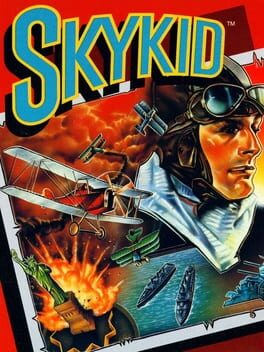

You are the legendary Red Baron, flying a plane through a horizontal side-scrolling scenery set during World War I. To complete a mission, you simply need to get to the landing spot on the other side without being shot down, but you can gain extra points by destroying enemy vehicles and planes. For huge points, pick up a bomb hidden in the level (you will be warned by a sound when approaching it) and drop it on a large structure. If you fail to land on the landing strip, you run out of fuel and crash. You can only shoot horizontally and diagonally by tilting the plane's nose. When in trouble, perform an aerial loop with the secondary button, this often destroys other planes and avoids bullets. There is a co-op mode with the character Max as well.
Also in series
Reviews View More
The title places the player in a biplane, whose mission is to bomb strategic enemy buildings by retrieving a bomb in the level, before dropping it. The plane is also capable of firing projectiles at a very reasonable rate, as well as doing high yo-yos, which give i-frames and allow our biplane to be positioned behind the opposing forces. The particularity of the title is that the projectiles are influenced by the angle of the aircraft, which requires more or less subtle manoeuvres to get out of the way of an enemy squadron or to dodge a salvo of projectiles. The idea is quite good and correctly implemented, but the title suffers from an acute repetition of its content, insofar as the same screens are repeated from one level to another. While the different enemy projectiles create novelty during the first three stages, they fail to create the necessary diversity over the twenty levels that Sky Kid offers. On the other hand, it doesn't even seem necessary to bomb the strategic targets, except for bonus points, which pushes the player to avoid it, since carrying the bomb prevents from doing any yo-yo.
Finally, the sexualisation present in Sky Kid is somewhat surprising. It is not new, since it is directly inherited from Japanese manga and anime, but being able to lift the dress of the Statue of Liberty seems quite exaggerated and superfluous. If this trope is not unique to Japanese media, the way in which it is implemented is old and relies on a particular connivance with the spectator: Miss Machiko (1980-1982) is surely the most important expression of it at that time, with the famous 'Maicchingu!' This, as well as the cheerleaders – or girlfriends? – of Baron and Max point to the normalisation of a heterosexual sexualisation of women in Japanese games, which the American localisations are happy to retain: the fact that the protagonists are birds in the Japanese version reinforces this observation. Beyond these remarks, Sky Kid remains an acceptable title, relatively original for its time, which nonetheless suffers from repetition, as much in its gameplay as in its artistic realisation. Fatally, the title never had a sequel and its director, Hiromu Nagashima, later moved on to baseball games – is that why the main theme of Sky Kid was used by the Osaka Kintetsu Buffaloes?

